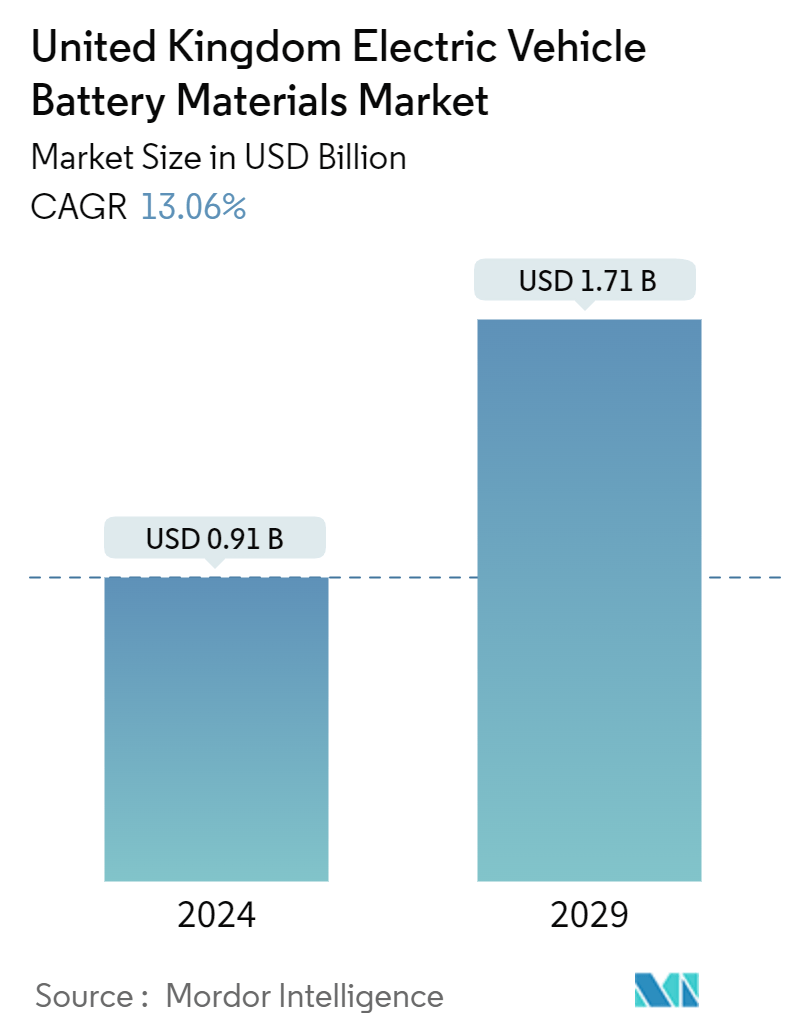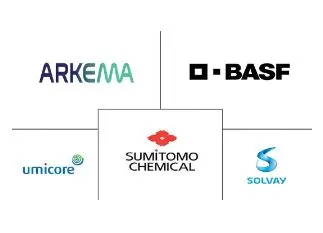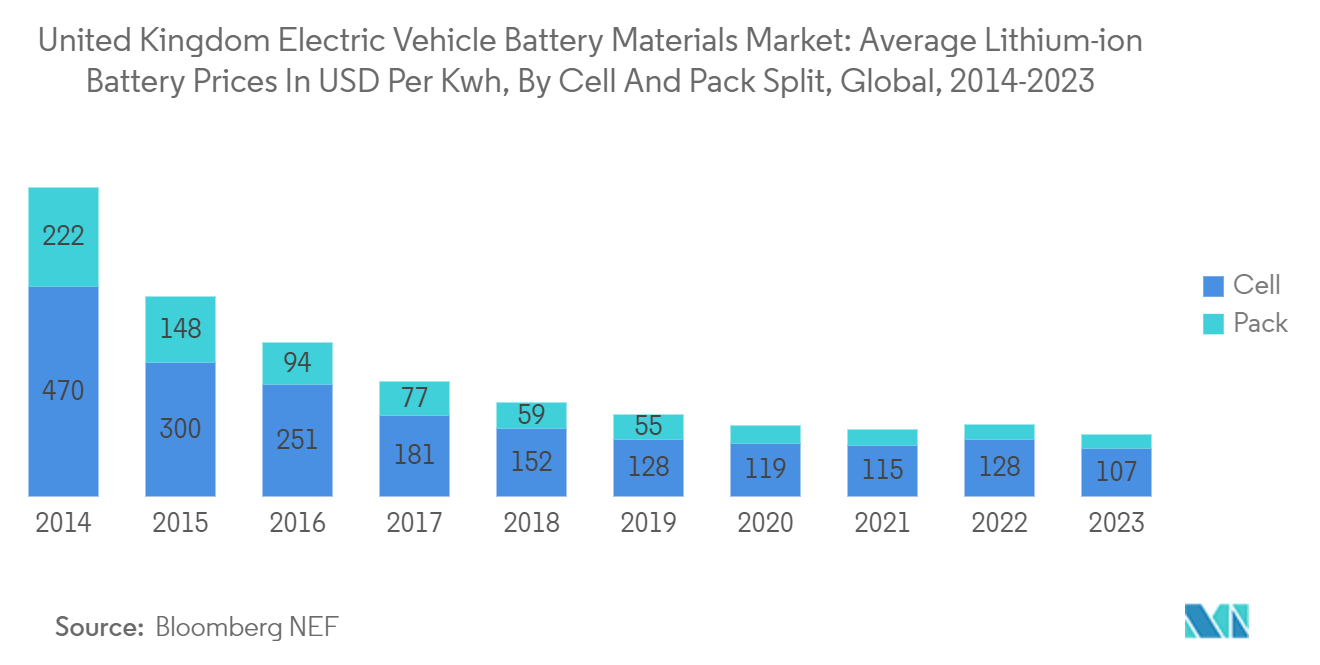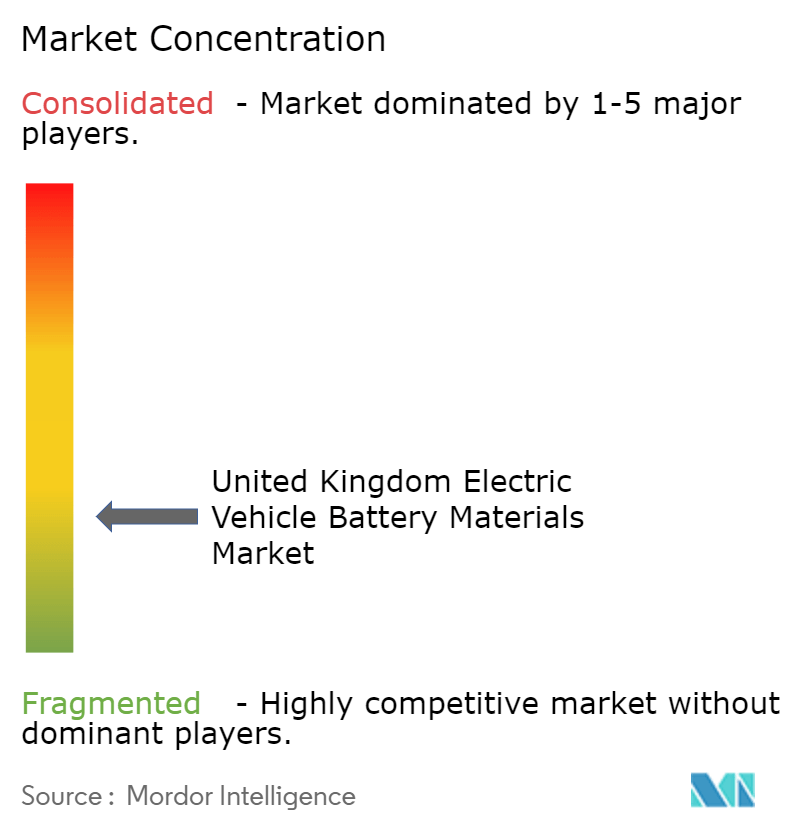United Kingdom Electric Vehicle Battery Materials Market Size

| Study Period | 2019 - 2029 |
| Base Year For Estimation | 2023 |
| Market Size (2024) | USD 0.91 Billion |
| Market Size (2029) | USD 1.71 Billion |
| CAGR (2024 - 2029) | 13.06 % |
| Market Concentration | Low |
Major Players
*Disclaimer: Major Players sorted in no particular order |
United Kingdom Electric Vehicle Battery Materials Market Analysis
The United Kingdom Electric Vehicle Battery Materials Market size is estimated at USD 0.91 billion in 2024, and is expected to reach USD 1.71 billion by 2029, at a CAGR of 13.06% during the forecast period (2024-2029).
- Over the medium term, growing electric vehicle (EV) sales and supportive government policies and regulations are expected to drive the demand for electric vehicle battery materials during the forecast period.
- On the other hand, the lack of raw material reserves can significantly restrain the growth of the electric vehicle battery materials market.
- Nevertheless, technological advancements in batteries like higher energy density, faster charging times, improved safety, and longer lifespan are expected to create significant opportunities for electric vehicle battery materials market players in the near future.
United Kingdom Electric Vehicle Battery Materials Market Trends
Growing Electric Vehicle (EVs) Sales Drives the Market
- In the United Kingdom (UK), rising electric vehicle (EV) sales are driving up the demand for EV battery materials. As the country embraces electric vehicles, the need for key battery components like lithium, cobalt, nickel, and graphite is surging. This heightened demand is not only stimulating local production but also attracting investments, thereby strengthening the UK's battery material supply chain.
- The UK is making a concerted shift towards clean energy, with electric vehicles taking center stage. Over recent years, EV sales in the region have seen exponential growth. For instance, the International Energy Agency (IEA) reported that in 2023, the UK sold 450,000 electric vehicles, marking a 21.62% increase from 2022. With the UK government launching several initiatives and projects, EV sales are projected to soar, consequently driving up the demand for battery materials.
- The UK government is actively nurturing the EV market through subsidies, tax incentives, and stringent emission regulations. These initiatives not only support the battery material sector but also elevate the nationwide demand for EVs. With ambitious targets set, the government envisions a fourfold surge in EV sales in the near future.
- As a testament to its commitment, the UK rolled out a Zero-Emission Vehicle (ZEV) mandate in 2023. This mandate stipulates that by 2030, 80% of new cars and 70% of new vans should be zero-emission, achieving a complete transition by 2035. Additionally, the sale of new petrol and diesel vehicles will halt by 2030, with all new vehicles required to be zero-emission by 2035. Such measures are set to accelerate both EV production and the demand for battery materials in the coming years.
- Furthermore, the UK's competitive EV landscape is driving innovations in battery technology. Local firms and research entities are investing in advanced materials, targeting improved energy density, longevity, and safety. Collaborations among major regional players aim to develop cutting-edge battery solutions, signaling a robust demand for EV batteries in the coming years.
- For instance, in January 2024, Microsoft, in partnership with the Pacific Northwest National Laboratory (PNNL) under the US Department of Energy, introduced a revolutionary material. This discovery, made using a combination of artificial intelligence (AI) and supercomputing, could reduce lithium consumption in batteries by an impressive 70%. Researchers also emphasize its potential to significantly enhance battery efficiency, particularly for electric vehicles (EVs) and related domains. Such advancements are poised to boost the demand for sophisticated EV batteries and, in turn, elevate the need for battery materials in the region.
- Given these developments, it's clear that the UK's initiatives and projects are set to not only bolster EV demand but also substantially increase the need for EV battery materials in the foreseeable future.

Lithium-Ion Battery Type Dominate the Market
- The growing production of lithium-ion batteries for electric vehicles (EVs) has significantly influenced the battery materials market. This surge in lithium-ion battery manufacturing has driven up the demand for lithium, with its discovery in various regions directly impacting raw material costs.
- Key market players, recognizing this trend, are ramping up investments in lithium reserves and R&D endeavors. Their goal is to bolster lithium-ion battery production and meet the escalating demand for battery raw materials. As new reserves are discovered, prices for lithium-ion batteries are notably declining.
- For instance, in 2023, battery prices dropped significantly to USD 139/kWh, marking a 13% decrease. With ongoing technological advancements and manufacturing efficiencies, experts predict prices could dip to USD 113/kWh by 2025 and plummet further to USD 80/kWh by 2030.
- Governments in the United Kingdom are actively promoting lithium-ion battery production for electric vehicles, driven by rising environmental concerns. With a strong focus on net-zero carbon emission targets, the government has launched numerous projects to boost lithium-ion battery production, aiming to meet the region's growing EV demand.
- In May 2023, Tata Motors, the owner of Jaguar Land Rover, announced plans for a state-of-the-art electric car battery plant in Somerset, southwest England, with investments reaching billions. Such strategic moves are set to accelerate the adoption of lithium-ion batteries as a pivotal clean energy source, amplifying the demand for battery materials in the foreseeable future.
- In recent years, the UK has been leading the charge in developing advanced battery recycling technologies for lithium-ion batteries. Companies and research institutions are innovating efficient methods to recover valuable materials like lithium, cobalt, and nickel from used batteries.
- In March 2024, Altilium, a UK company specializing in sustainable battery waste recycling, announced a collaboration with Nissan. This partnership aims to implement advanced recycling technologies, targeting a reduction in the carbon footprint of new UK-made batteries and a decrease in reliance on imported raw materials. This initiative, part of the Advanced Propulsion Centre's (APC) GBP 30 million (USD 38 million) project, saw Altilium securing a notable grant of GBP 15 million (USD 19 million). Such initiatives not only accelerate the production of lithium-ion raw materials but also bolster the future production of EV battery materials.
- Given these advancements and initiatives, a significant increase in the demand for EV battery materials is anticipated during the forecast period.

United Kingdom Electric Vehicle Battery Materials Industry Overview
United Kingdom's electric vehicle battery materials market is semi-fragmented. Some key players (not in particular order) are Sumitomo Chemical Co., Ltd., BASF SE, Arkema SA, Solvay SA, Umicore SA, among others.
United Kingdom Electric Vehicle Battery Materials Market Leaders
-
Sumitomo Chemical Co., Ltd
-
Solvay SA
-
BASF SE
-
Arkema SA
-
Umicore SA
*Disclaimer: Major Players sorted in no particular order

United Kingdom Electric Vehicle Battery Materials Market News
- February 2024: Volkswagen Group United Kingdom Ltd. inked a partnership with Ecoba, a prominent player in battery recycling, to repurpose lithium-ion materials from electric vehicle (EV) batteries. This collaboration not only aids VWG UK in advancing a circular energy model but also underscores the automotive giant's commitment to bolstering sustainability in the United Kingdom.
- December 2023: Researchers at the University of Birmingham showcased a technique for repurposing end-of-life battery waste into materials suitable for advanced battery cathodes. Leveraging material salvaged from retired EV batteries, the team crafted compounds featuring a disordered rocksalt (DRX) structure. This DRX configuration, viewed as a viable substitute for the typical layered structure in traditional cathode materials, not only enhances cathode capacity but also paves the way for the creation of lithium-ion batteries with higher energy densities.
United Kingdom Electric Vehicle Battery Materials Market Report - Table of Contents
1. INTRODUCTION
1.1 Scope of the Study
1.2 Market Definition
1.3 Study Assumptions
2. EXECUTIVE SUMMARY
3. RESEARCH METHODOLOGY
4. MARKET OVERVIEW
4.1 Introduction
4.2 Market Size and Demand Forecast in USD billion, till 2029
4.3 Recent Trends and Developments
4.4 Government Policies and Regulations
4.5 Market Dynamics
4.5.1 Drivers
4.5.1.1 Growing Electric Vehicle Sales
4.5.1.2 Supportive Government Policies and Regulations
4.5.2 Restraints
4.5.2.1 Dependence on Raw Material Supply
4.6 Supply Chain Analysis
4.7 PESTLE Analysis
4.8 Investment Analysis
5. MARKET SEGMENTATION
5.1 Battery Type
5.1.1 Lithium-ion Battery
5.1.2 Lead-Acid Battery
5.1.3 Others
5.2 Material
5.2.1 Cathode
5.2.2 Anode
5.2.3 Electrolyte
5.2.4 Separator
5.2.5 Others
6. COMPETITIVE LANDSCAPE
6.1 Mergers and Acquisitions, Joint Ventures, Collaborations, and Agreements
6.2 Strategies Adopted by Leading Players
6.3 Company Profiles
6.3.1 Sumitomo Chemical Co., Ltd.
6.3.2 BASF SE
6.3.3 Arkema SA
6.3.4 Solvay SA
6.3.5 Umicore SA
6.3.6 Mitsubishi Chemical Group Corporation
6.3.7 Fiamm Energy Technology
6.3.8 ENTEK International LLC
6.3.9 Johnson Matthey
6.3.10 Epsilon Adavnced Material
- *List Not Exhaustive
6.4 List of Other Prominent Companies
6.5 Market Ranking/ Share Analysis
7. MARKET OPPORTUNITIES AND FUTURE TRENDS
7.1 Advancements in Battery Technology
United Kingdom Electric Vehicle Battery Materials Industry Segmentation
Electric vehicle (EV) battery materials refer to the raw materials and compounds used in the manufacturing of batteries specifically designed for electric vehicles. These materials are critical for the performance, energy density, lifespan, and safety of EV batteries.
United Kingdom's electric vehicle battery materials market is Segmented by Battery Type and Material. By battery type, the market is segmented into Lithium-Ion Battery, Lead-Acid Battery, and Others. By materials, the market is segmented into Cathode, Anode, Electrolyte, Separator, and Others. The Report Offers the Market Size and Forecasts in Revenue (USD) for all the Above.
| Battery Type | |
| Lithium-ion Battery | |
| Lead-Acid Battery | |
| Others |
| Material | |
| Cathode | |
| Anode | |
| Electrolyte | |
| Separator | |
| Others |
United Kingdom Electric Vehicle Battery Materials Market Research FAQs
How big is the United Kingdom Electric Vehicle Battery Materials Market?
The United Kingdom Electric Vehicle Battery Materials Market size is expected to reach USD 0.91 billion in 2024 and grow at a CAGR of 13.06% to reach USD 1.71 billion by 2029.
What is the current United Kingdom Electric Vehicle Battery Materials Market size?
In 2024, the United Kingdom Electric Vehicle Battery Materials Market size is expected to reach USD 0.91 billion.
Who are the key players in United Kingdom Electric Vehicle Battery Materials Market?
Sumitomo Chemical Co., Ltd, Solvay SA, BASF SE, Arkema SA and Umicore SA are the major companies operating in the United Kingdom Electric Vehicle Battery Materials Market.
What years does this United Kingdom Electric Vehicle Battery Materials Market cover, and what was the market size in 2023?
In 2023, the United Kingdom Electric Vehicle Battery Materials Market size was estimated at USD 0.79 billion. The report covers the United Kingdom Electric Vehicle Battery Materials Market historical market size for years: 2019, 2020, 2021, 2022 and 2023. The report also forecasts the United Kingdom Electric Vehicle Battery Materials Market size for years: 2024, 2025, 2026, 2027, 2028 and 2029.
United Kingdom Electric Vehicle Battery Materials Industry Report
Statistics for the 2024 United Kingdom Electric Vehicle Battery Materials market share, size and revenue growth rate, created by Mordor Intelligence™ Industry Reports. United Kingdom Electric Vehicle Battery Materials analysis includes a market forecast outlook for 2024 to 2029 and historical overview. Get a sample of this industry analysis as a free report PDF download.



